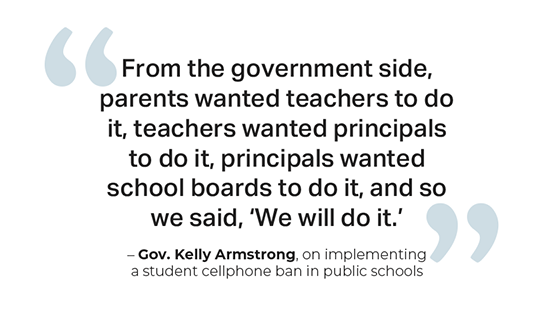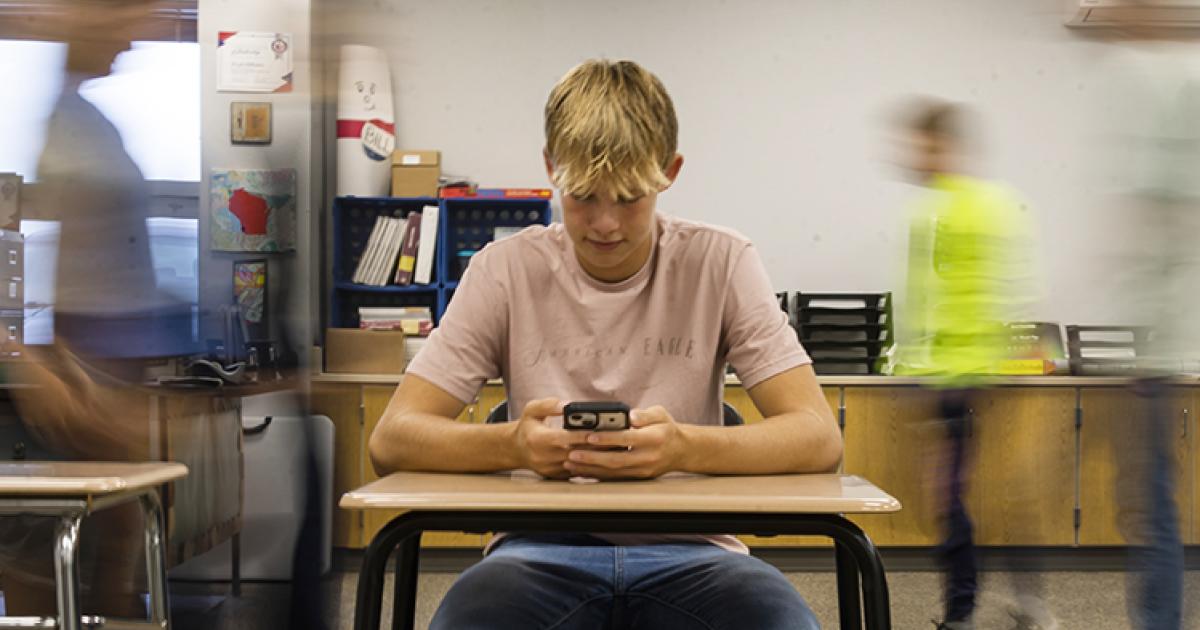New state law bans student cellphones in public schools
Gov. Kelly Armstrong and First Lady Kjersti Armstrong were among students at Centennial Elementary School in Bismarck for the April 25 bill signing of the law requiring public schools to institute phone-free school policies. PHOTO COURTESY N.D. GOVERNOR'S OFFICE
This fall, students returning to school will say goodbye to summer and their cellphones.
In April, Gov. Kelly Armstrong signed into law a bill banning student cellphone use in the state’s public schools.
The law requires cellphones to be secured during instructional time, from the start of the school day to dismissal, or “bell to bell.” It does not include school-owned devices such as laptops and tablets used for educational purposes, but covers a variety of personal devices, including smartwatches and tablets, that could distract students during the day.
There are exceptions for medical and accessibility reasons, and school districts will be required to collect and report annual data to measure the impact of the policy on student behavior, mental health, disciplinary incidents, school attendance and academic performance.
The mandate does not apply to private schools.
While phone usage in schools and among youth has been a concern for some time, it was brought to the forefront of public discussion with the publishing of the book, “The Anxious Generation,” by Jonathan Haidt in 2024. The book connects the rise of the digital world to mental health issues in young people, specifically anxiety, depression, cyberbullying and digital addiction. It even calls for legislative involvement to create a safer digital environment.
“‘The Anxious Generation,’ I think that is really one of the main points that spearheaded all of this happening and just realizing the power of cellphones,” says Tara Hofmann, principal at Medina Public Schools. “I think it came down to how much it is affecting their mental health, their ability to learn, their ability to communicate, their ability to be with other people in person.”
Kirsten Baesler, N.D. superintendent of public instruction, also referenced the research and studies in Haidt’s book, saying it “solidified the case for our educators.”
“They are actually being able to put a name and reason to the things that educators have been witnessing,” Baesler says.
The book cites several studies and research to support its claims: spikes in major depressive episodes, percentage of undergraduates with a mental illness and anxiety prevalence that occurs after around the year 2010 and especially in Gen Z, or people born between 1997 and 2012. Haidt correlates these spikes with the rise in the use of cellphones and personal electronic devices and the drop in child play, spending less time with others and more.
Before the legislation passed, schools had free rein to decide how to tackle cellphones in school.
Medina Public Schools implemented a bell-to-bell no cellphone policy last year. The prior year, the district had a no cellphone policy during classtime.
“I think the overall thought is this is going to be so good for our students,” Hofmann says.
BELL TO BELL
While the Medina school district’s first student cellphone policy reduced distractions in class, it restricted cellphones even more last year, Hoffman says, because students were interacting more with their phones in the hallway or lunchroom than with their peers.
“Go to a lunchroom where they don’t have a cellphone ban and then go to a lunchroom where they have a cellphone ban and watch the difference between how kids interact with each other,” Armstrong says. “In the ones without cellphones, they are laughing, they are throwing food at each other, they are doing those things. In the one that does not have a cellphone ban, it is as quiet as the quietest library in the state during lunch hour.”
According to the governor, early talk of the bill considered requiring all schools to simply have a cellphone policy in place. But Armstrong says experts urged lawmakers, if they were going to do something, a statewide bell-to-bell policy would have the biggest impact.
Armstrong was comfortable supporting the statewide ban because the data does not discriminate. Whether a class of 20 in rural Mott or 200 in urban West Fargo, cellphone use and mental health effects are correlative for any student with a cellphone, he says.
“From the government side, parents wanted teachers to do it, teachers wanted principals to do it, principals wanted school boards to do it, and so we said, ‘We will do it,’” Armstrong says.
SAFE SCHOOLS
“There are certain things that are the state’s responsibility. Health and safety of our children is paramount, right?” Baesler says.
Baesler considers the cellphone ban an extension of government regulation aimed at keeping children safe in school.
“Those regulations happen all day, every day to keep our children safe. This is exactly what we are talking about, in my opinion and obviously the legislators’ opinions, health is health. There shouldn’t be a differentiation between physical health and mental health,” Baesler says.
But while N.D. Century Code mandates school safety regulations, including tornado, fire and lockdown drills, for private schools, as well, the student cellphone ban does not extend to private schools.
According to Baesler, the original bill language included nonpublic and private tuition schools, but when the Legislature was unable to override Gov. Armstrong’s veto of House Bill 1540, the Legislature removed private schools from the cellphone bill. House Bill 1540 was hotly debated during the legislative session. It would have provided private school vouchers for families who choose to send their children to private school. Opposition argued the bill would divert funding from public schools and disproportionately affect rural schools.
Student safety was one of the concerns noted by the governor and others on the topic. According to Armstrong, it is safer for students to be focused on their leaders, evacuation and protocols during an emergency rather than distracted by a phone.
“I hope private schools do it, but I don’t think we, as the state of North Dakota, should be in the business of overregulating private school or home school,” Armstrong says.
PUT TO THE TEST
Hofmann, Baesler and Armstrong acknowledge there will be a learning curve for parents to not have cellphone access to their children during the school day, but all believe the benefits will outweigh the negatives.
In Medina, Hofmann is hopeful parents can adjust to the new cellphone policy by either calling the school office like the “olden days,” or emailing their children on school-issued laptops or tablets.
“I just really hope that we can have a partnership with families, parents and students. (I hope) for us all to realize that the goal of this is to help us minimize and deal with the distractions, so that we can be more present with what we are learning, the conversations we are having or the event that we are at in the moment. I think this was our state Legislature’s way of saying that this is important,” Hofmann says.
The bell-to-bell cellphone ban will be put to the test this month, as students, educators, administrators and coaches head back to school. It’s not a letter grade on the line – it’s the hope of improved mental health, better academic focus and giving students a break from the digital world.
“We talk a lot about agriculture resources and energy resources and all of the things that have made North Dakota great. But our best resources are sitting in a classroom, graduating from high school in May and are waiting to come back for their senior year,” Armstrong says. “And education matters, and it matters more now than ever, because everything is moving so fast.”
___
Kennedy DeLap is interning with North Dakota Living. She can be reached at kdelap@ndarec.com.












